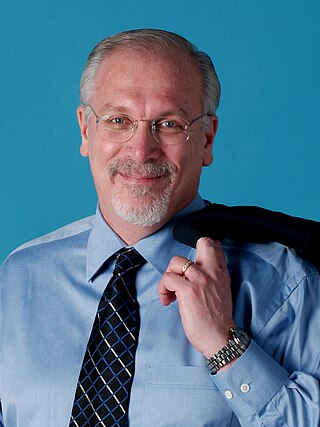Related Research Articles

Sonification is the use of non-speech audio to convey information or perceptualize data. Auditory perception has advantages in temporal, spatial, amplitude, and frequency resolution that open possibilities as an alternative or complement to visualization techniques.
Sensory substitution is a change of the characteristics of one sensory modality into stimuli of another sensory modality.
Multimodal interaction provides the user with multiple modes of interacting with a system. A multimodal interface provides several distinct tools for input and output of data.

The College of Computing is a college of the Georgia Institute of Technology, a public research university in Atlanta, Georgia. It is divided into four schools: the School of Computer Science, the School of Interactive Computing, the School of Computational Science & Engineering, and the School of Cybersecurity and Privacy. The College of Computing's programs are consistently ranked among the top 10 computing programs in the nation. In 2022, U.S. News & World Report ranked the Computer Science graduate program #6 in the U.S. In 2016, Times Higher Education and the Wall Street Journal ranked the College #5 in the world.
Auditory display is the use of sound to communicate information from a computer to the user. The primary forum for exploring these techniques is the International Community for Auditory Display (ICAD), which was founded by Gregory Kramer in 1992 as a forum for research in the field.

Richard Allan DeMillo is an American computer scientist, educator and executive. He is Professor and holds the Charlotte B. and Roger C. Warren Chair in Computing at the Georgia Institute of Technology.
Elizabeth D. "Beth" Mynatt is the Dean of the Khoury College of Computer Sciences at Northeastern University. She is former executive director of the Institute for People and Technology, director of the GVU Center at Georgia Tech, and Regents' and Distinguished Professor in the School of Interactive Computing, all at the Georgia Institute of Technology. In 2024, she was elected into the prestigious American Academy of Arts and Sciences.

GroupLens Research is a human–computer interaction research lab in the Department of Computer Science and Engineering at the University of Minnesota, Twin Cities specializing in recommender systems and online communities. GroupLens also works with mobile and ubiquitous technologies, digital libraries, and local geographic information systems.

David Worrall is an Australian composer and sound artist working a range of genres, including data sonification, sound sculpture and immersive polymedia as well as traditional instrumental music composition.

Human–computer interaction (HCI) is research in the design and the use of computer technology, which focuses on the interfaces between people (users) and computers. HCI researchers observe the ways humans interact with computers and design technologies that allow humans to interact with computers in novel ways. A device that allows interaction between human being and a computer is known as a "Human-computer Interface".
Sonic interaction design is the study and exploitation of sound as one of the principal channels conveying information, meaning, and aesthetic/emotional qualities in interactive contexts. Sonic interaction design is at the intersection of interaction design and sound and music computing. If interaction design is about designing objects people interact with, and such interactions are facilitated by computational means, in sonic interaction design, sound is mediating interaction either as a display of processes or as an input medium.

Eric Joel Horvitz is an American computer scientist, and Technical Fellow at Microsoft, where he serves as the company's first Chief Scientific Officer. He was previously the director of Microsoft Research Labs, including research centers in Redmond, WA, Cambridge, MA, New York, NY, Montreal, Canada, Cambridge, UK, and Bangalore, India.
Sound and music computing (SMC) is a research field that studies the whole sound and music communication chain from a multidisciplinary point of view. By combining scientific, technological and artistic methodologies it aims at understanding, modeling and generating sound and music through computational approaches.
Audification is an auditory display technique for representing a sequence of data values as sound. By definition, it is described as a "direct translation of a data waveform to the audible domain." Audification interprets a data sequence and usually a time series, as an audio waveform where input data are mapped to sound pressure levels. Various signal processing techniques are used to assess data features. The technique allows the listener to hear periodic components as frequencies. Audification typically requires large data sets with periodic components.

Irfan Aziz Essa is a professor in the School of Interactive Computing of the College of Computing, and adjunct professor in the School of Electrical and Computer Engineering at the Georgia Institute of Technology. He is an associate dean in Georgia Tech's College of Computing and the director of the new Interdisciplinary Research Center for Machine Learning at Georgia Tech (ML@GT).
Charles (Chuck) M. Eastman was a professor and a pioneer in the areas of design cognition, building information modeling (BIM), solid and parametric modeling, engineering databases, product models, and interoperability. He is best known for his work on building description system, which later gave him a title as the 'father of BIM.'

Bernd Johann Krämer is a German computer scientist and professor emeritus of the Faculty of Mathematics and Informatics.
Data sonification is the presentation of data as sound using sonification. It is the auditory equivalent of the more established practice of data visualization.
Eric Gilbert is an American computer scientist and the John Derby Evans Associate Professor in the University of Michigan School of Information, with a courtesy appointment in CSE. He is known for his work designing and analyzing social media.
Gregory Paul Kramer, is an American composer, researcher, inventor, meditation teacher and author. In 1975 he co-founded Electronic Musicmobile, a pioneer synthesizer ensemble later renamed Electronic Art Ensemble, in which Kramer was a musician and composer. His pioneering work extended to developing synthesizer and related equipment. Kramer also co-founded the not-for-profit arts organization Harvestworks in New York City. He is recognized as the founding figure of the intensely cross-disciplinary field of data sonification. Since 1980, Kramer teaches Buddhist meditation. He is credited as developer of Insight Dialogue, an interpersonal meditation practice. Kramer is the author of several books in diverse fields, as well as (co-)author of scientific papers in the field of data sonification.
References
- ↑ Kramer, G.; Walker, B.N. (2005), "Sound science: Marking ten international conferences on auditory display", ACM Transactions on Applied Perception, 2 (4): 383–388, CiteSeerX 10.1.1.88.7945 , doi:10.1145/1101530.1101531, S2CID 1187647
- ↑ "International Conference on Auditory Display (ICAD)" . Retrieved 4 July 2018.
- ↑ "The ICAD Board". Archived from the original on 17 October 2016. Retrieved 21 July 2016.
- ↑ "Georgia Tech Sonification Lab -- people" . Retrieved 25 October 2011.
- ↑ "Prof Paul Vickers, Professor, Department: Computer and Information Sciences" . Retrieved 28 February 2023.